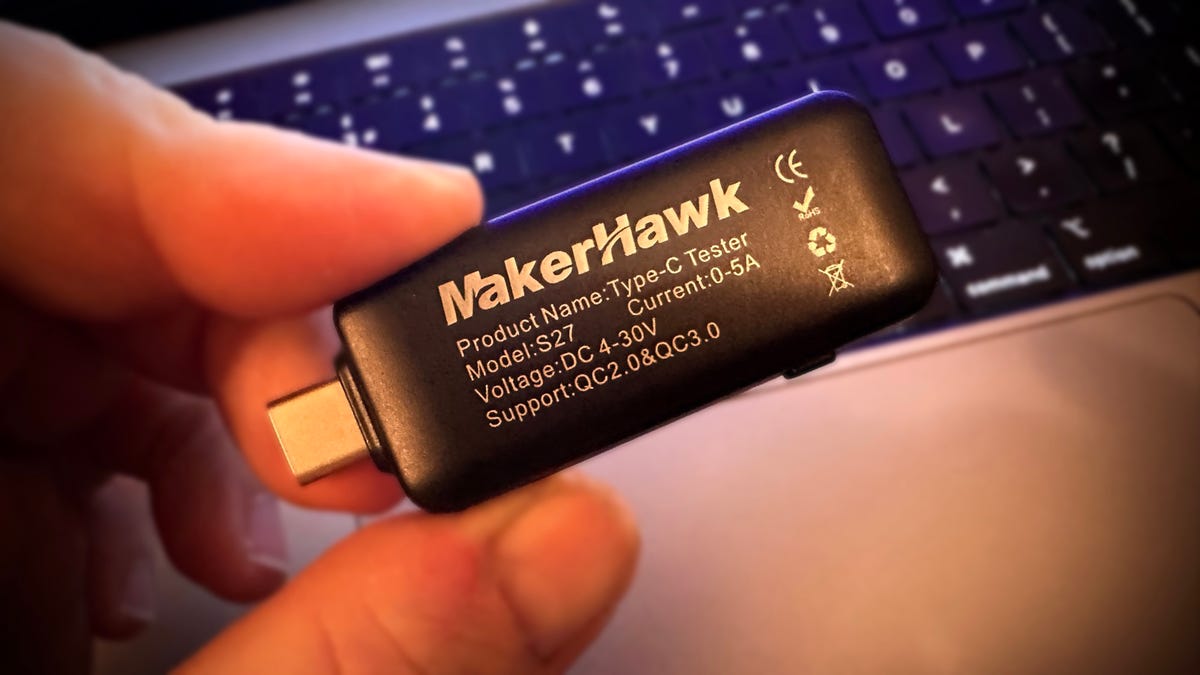
MakerHawk Type-C USB-C meter tester.
Adrian Kingsley-Hughes/ZDNET
Featured reviews
If you’re thinking about taking your tech toolbox beyond screwdrivers and pry tools, then a tool that I recommend adding to your arsenal is a USB port tester.
And as ports are making the shift away from USB-A to USB-C, I recommend going for a USB-C port tester.
The MakerHawk Type-C USB-C meter tester can cover everything you can throw at it, which is why it’s become my test meter of choice for a whole host of applications.
Also: Using the wrong USB-C cable can damage your tech. Here’s how to avoid that
MakerHawk Type-C USB-C meter tester tech specs
- Voltage: 4-30V
- Current: 0-5A
- Capacity range: 0-999999mAh
- Energy range: 0-999999mAh
- Timer: 0-99 hours
- Power: 0-150W
- Charging resistance measurement: 0-999.9 Ohms
- Internal thermometer range: 0-80ºC
- Data voltage range: 0-10V
I like that the power range of this meter goes up to 150W because this easily covers modern 100W USB-C chargers (a number of my older USB-C meters didn’t do this), and having a ceiling of 150W also means that this meter can work with Apple’s 140W USB-C MagSafe charger for the newer M1 and M2 powered MacBooks.
Also: The 5 best MagSafe accessories
Another feature that I really like about this meter is that there’s only one button. It’s simple to use, especially compared to some meters that feel like they are needlessly complicated or just badly designed. Instructions for these meters are never the best (if you get any in your language to begin with), so having a meter that’s easy to use makes all the difference.
I also like the colorful LCD display that shows me all the information I need to see without having to page through endless screens. However, the text is on the small side, so bear that in mind if this is something that might be a difficulty for you.
I’ve tested the accuracy of the meter, and the error range seems to be well below 5%, which — for me — is perfectly acceptable.
And all this for a price of $16. Yes, $16. This makes the MakerHawk Type-C USB-C meter tester a total steal.
For a $16 USB meter, this is excellent value and supports the 140W Apple MagSafe charger.
Adrian Kingsley-Hughes/ZDNET
So, what do I use USB testers for?
Loads of stuff. Here are just a few things I use it for:
- Is a device taking a charge? This can tell you if a device is totally dead (where it won’t be taking a charge), or maybe the screen is dead (I find this a particularly useful test for things like Nintendo Switch consoles, smartphones, or in-car GPS units).
- Is a charger working and delivering the power it claims? Plug the meter in, connect the charge cable to the device, and find out.
- Is charging intermittent? Plug the meter in and watch. Maybe wiggle the port or the cable to see if the charging drops out.
- Is the rechargeable battery worn out? Run the device until it’s at zero percent, plug the meter in and charge it, and the meter will record how much mAh has been delivered. You can check this against the published specs for the device.
- Is a power bank giving you the capacity it claims? Again, run it flat and plug the meter in and charge it, and let the meter record how much mAh has been delivered, and check this against the published specs for the device.
It’s a really versatile tool, and one that can be used to test and diagnose all sorts of issues.
Also: This tiny USB-C charger packs a lot of power
Testing power bank outputs.
Adrian Kingsley-Hughes/ZDNET
The MakerHawk USB-C meter is one of my main go-to devices for testing and diagnosing problems. And at only $16, that’s cheaper than a decent set of screwdrivers.